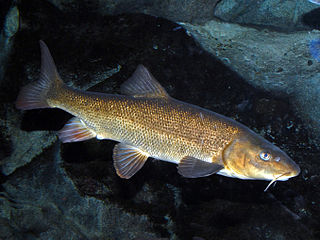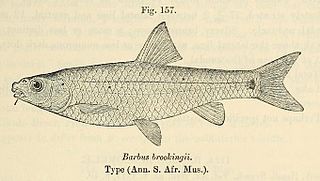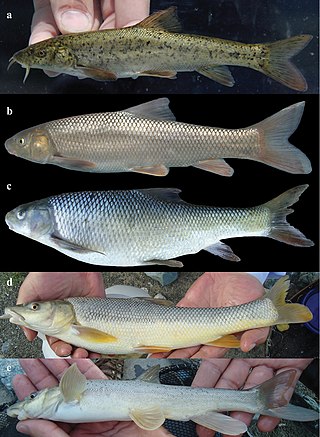
Barbus is a genus of ray-finned fish in the family Cyprinidae. The type species of Barbus is the common barbel, first described as Cyprinus barbus and now named Barbus barbus. Barbus is the namesake genus of the subfamily Barbinae, but given their relationships, that taxon is better included in the Cyprininae at least for the largest part.

Barbels are group of carp-like freshwater fish, almost all of the genus Barbus. They are usually found in gravel and rocky-bottomed moderate-flowing rivers with high dissolved oxygen content, known as the Barbel zone. A typical adult barbel can range from 25 to 240 cm in length and weigh between 200 g (7.1 oz) and 200 kg (440 lb), depending on species.

The common barbel is a species of freshwater fish belonging to the family Cyprinidae. It shares the common name 'barbel' with its many relatives in the genus Barbus, of which it is the type species. In Great Britain it is usually referred to simply as the barbel; similar names are used elsewhere in Europe, such as barbeau in France and flodbarb in Sweden. The name derives from the four whiskerlike structures located at the corners of the fish's mouth, which it uses to locate food.
Stomias boa boa, also called the scaly dragonfish or boa dragonfish, is a subspecies of abyssal barbeled dragonfish of the family Stomiidae. It is found at great depths worldwide in tropical to temperate oceans but is absent from the northern Pacific and northwest Atlantic Oceans.

Pseudobarbus is a ray-finned fish genus in the family Cyprinidae. The type species is Burchell's redfin. The scientific name is derived from the Ancient Greek pseudes ("false") and the Latin word barbus. This genus contains some of the South African redfins. It was originally proposed as a subgenus, but has since been found worthy of recognition as a full genus.

The Ripon barbel is an East African ray-finned fish species in the family Cyprinidae. A notably large barb, its maximum recorded total length is 90 cm (35 in).
Barbus cyclolepis, the round-scaled barbel, is a freshwater fish species in the family Cyprinidae. It is found in Bulgaria, Greece, and Turkey. Its natural habitats are rivers and intermittent rivers. It is not considered a threatened species by the IUCN.
Barbus figuigensis is a doubtfully distinct ray-finned fish species in the family Cyprinidae.

Luciobarbus graellsii is a ray-finned fish species in the family Cyprinidae. It is here placed in Luciobarbus following the IUCN, but that genus is very closely related to the other typical barbels and perhaps better considered a mere subgenus of Barbus. The Andalusian barbel was formerly included in L. bocagei as subspecies.

Labeobarbus intermedius is an East African ray-finned fish species in the family Cyprinidae. Like the closely related yellowfish, it is hexaploid. A large species, the maximum recorded standard length is nearly 50 cm (20 in). This species has a subspecies named Labeobarbus intermedius intermedius.
Barbus labiosa is a doubtfully distinct ray-finned fish species in the family Cyprinidae.

The Italian barbel is a species of freshwater fish in the family Cyprinidae, nearly related to the common barbel Barbus barbus. The name barbel derived from the Latin barba, meaning beard, a reference to the two pairs of barbels, a longer pair pointing forwards and slightly down positioned, on the side of the mouth.

The border barb is a ray-finned fish species in the family Cyprinidae. It is the only species in the genus Amatolacypris. Like Pseudobarbus, it is tetraploid.
Luciobarbus is a genus of ray-finned fishes in the family Cyprinidae. Its members are found in fresh and brackish waters of southern Europe, northern Africa, the wider Near East, the Aral and Caspian Seas, and rivers associated with these. Several species in the genus are threatened. Most species are fairly small to medium-sized cyprinids, but the genus also includes several members that can surpass 1 m (3.3 ft) in length and the largest, the mangar can reach 2.3 m (7.5 ft).

Barbinae are a subfamily of fish included in the family Cyprinidae. The taxonomy for this group has not been entirely worked out as some genera historically considered within it are still considered incertae sedis with respect to being a member of the family, and may be included here, while others may be moved to other subfamilies.
The lizard barbel, also known as Kura barbel, is a species of freshwater cyprinid fish from the Near East region. Kosswig's barbel is now a synonym, which also places the species in the Tigris–Euphrates river system of the Middle east.

The Peipsi whitefish is a freshwater whitefish of the family Salmonidae that naturally occurs in Lake Peipus on the border of Estonia and Russia, from where it also ascends to Lake Võrtsjärv to spawn. It has been introduced in Lake Burtnieks (Latvia), Gulf of Riga, many lakes of northern Russia, Poland, Germany, Netherlands, Japan, Lake Sevan (Armenia) and Balkash (Kazakhstan). It is a benthopelagic fish up to 60 cm long.
Kosswig's barbel is a species of ray-finned fish in the genus Luciobarbus. It is found in the Tigris watershed in Turkey.
Leptostomias gladiator is a species of fish in the family Stomiidae. It is sometimes called the scaleless dragonfish, but that name is shared with many other species.

Barbus cyri, the Kura barbel, is a species of freshwater cyprinid fish from the Near East region.











